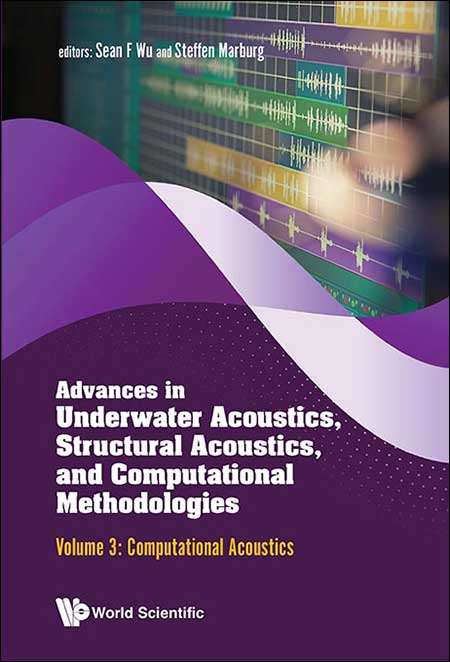System Upgrade on Tue, May 28th, 2024 at 2am (EDT)
Existing users will be able to log into the site and access content. However, E-commerce and registration of new users may not be available for up to 12 hours.For online purchase, please visit us again. Contact us at customercare@wspc.com for any enquiries.
This volume's review articles provide summaries of theories including the benchmark study on eigenfrequencies of fluid-loaded structures, and the Burton and Miller method, while the new methodologies range from a coupled boundary element and energy flow method, to an efficient approach to the simulation of acoustic radiation. The book concludes with promising applications like a comparison of transient infinite elements and transient Kirchhoff integral methods, as well as a fast multi-frequency iterative acoustic boundary element method.
Contents:- Review Articles:
- Review: The Use of Equivalent Source Method in Computational Acoustics (Seongkyu Lee)
- A Benchmark Study on Eigenfrequencies of Fluid-Loaded Structures (Felix Kronowetter, Suhaib Koji Baydoun, Martin Eser, Lennart Moheit, and Steffen Marburg)
- Recent Advances in Acoustic Boundary Element Methods (Simone Preuss, Caglar Gurbuz, Christopher Jelich, Suhaib Koji Baydoun, and Steffen Marburg)
- Computational Acoustics in Multi-Field Problems (Manfred Kaltenbacher)
- The Burton and Miller Method: Unlocking Another Mystery of Its Coupling Parameter (Steffen Marburg)
- New Methodologies:
- A Coupled BEM And Energy Flow Method for Mid-High Frequency Internal Acoustic (Sbastien Besset, M N Ichchou and L Jézéquel)
- Fast Multipole Boundary Element Method for Low-Frequency Acoustic Problems Based on A Variety of Formulations (Yosuke Yasuda, Takuya Oshima, Tetsuya Sakuma, Arief Gunawan and Takayuki Masumoto)
- Sound Source Localization in Three-Dimensional Space in Real Time with Redundancy Checks (Na Zhu and Sean F Wu)
- A Low-High Frequency Formulation for Fast Acoustic Calculations (Sébastien Besset)
- Fast Frequency-Domain Forward and Inverse Methods for Acoustic Scattering from Inhomogeneous Objects in Layered Media (Jing He Li and Qing Huo Liu)
- Infinite Elements and Their Influence on Normal and Radiation Modes in Exterior Acoustics (P Lennart Moheit and Steffen Marburg)
- Acoustical Green's Function and Boundary Element Techniques for 3D Half-Space Problems (Rafael Piscoya and Martin Ochmann)
- More Than Six Elements Per Wavelength: The Practical Use of Structural Finite Element Models and Their Accuracy in Comparison with Experimental Results (P Langer, M Maeder, C Guist, M Krause, and S Marburg)
- A Pollution Effect in the Boundary Element Method for Acoustic Problems (Steffen Marburg)
- A New Test Function for Acoustic Computations with Meshless Methods (Hakan Dogan and Martin Ochmann)
- An Efficient Approach to the Simulation of Acoustic Radiation from Large Structures with FEM (Marc Zarnekow, Frank Ihlenburg, and Thomas Grätsch)
- New Applications:
- A Comparison of Transient Infinite Elements and Transient Kirchhoff Integral Methods for Far Field Acoustic Analysis (Timothy F Walsh, Andrea Jones, Manoj Bhardwaj, Clark Dohrmann, Garth Reese, And Riley Wilson)
- Stress–Velocity Complete Radiation Boundary Conditions (Daniel Rabinovich, Dan Givoli, Thomas Hagstrom, And Jacobo Bielak)
- Implementation of Different Formulas for Special Green's Functions in a 3D Half-Space BEM (Rafael Piscoya and Martin Ochmann)
- Closed-Form Evaluation of Potential Integrals in the Boundary Element Method (Michael Carley)
- Spectral Stochastic Infinite Element Method in Vibroacoustics (Felix Kronowetter, Lennart Moheit, Martin Eser, Kian K. Sepahvand, and Steffen Marburg)
- Subdivision Surfaces — Boundary Element Accelerated by Fast Multipole for the Structural Acoustic Problem (Leilei Chen, Chuang Lu, Wenchang Zhao, Haibo Chen, and Changjun Zheng)
- The Double Absorbing Boundary Method Incorporated in a High-Order Spectral Element Formulation (Symeon Papadimitropoulus, Daniel Rabinovich, and Dan Givoli)
- Application Limits of Conservative Source Interpolation Methods Using a Low Mach Number Hybrid Aeroacoustic Workflow (Stefan Schoder, Andreas Wurzinger, Clemens Junger, Michael Weitz, Clemens Freidhager, Klaus Roppert, and Manfred Kaltenbacher)
- Low-Rank Iteration Schemes for the Multi-Frequency Solution of Acoustic Boundary Element Equations (Suhaib Koji Baydoun, Matthias Voigt, and Steffen Marburg)
- Solving Thin-Body Acoustic Problems Over an Impedance Plane with a Fast Multipole Indirect Boundary Element Method (Meng-Hui Liang, Yong-Bin Zhang, Chang-Jun Zheng, Shuai Wang and Chuan-Xing Bi)
- Efficient Analysis of Energy-Based Surface Contributions for an Entire Acoustic Cavity (Caglar Gurbuz and Steffen Marburg)
- Revising the Boundary Element Method for Thermoviscous Acoustics: An Iterative Approach via Schur Complement (Simone Preuss, Mikkel Paltorp, Alexis Blanc, Vicente Cutanda Henríquez, and Steffen Marburg)
- On the Effect of Boundary Conditions on Porous Absorber Characterization and Simulations (Mariia Bronzova, Arnaud Bocquillet, and Martin Schanz)
- A Fast Multi-Frequency Iterative Acoustic Boundary Element Method Solver Based on a Preconditioned Accelerated Recycling Strategy (Dionysios Panagiotopoulos, Wim Desmet, and Elke Deckers)






